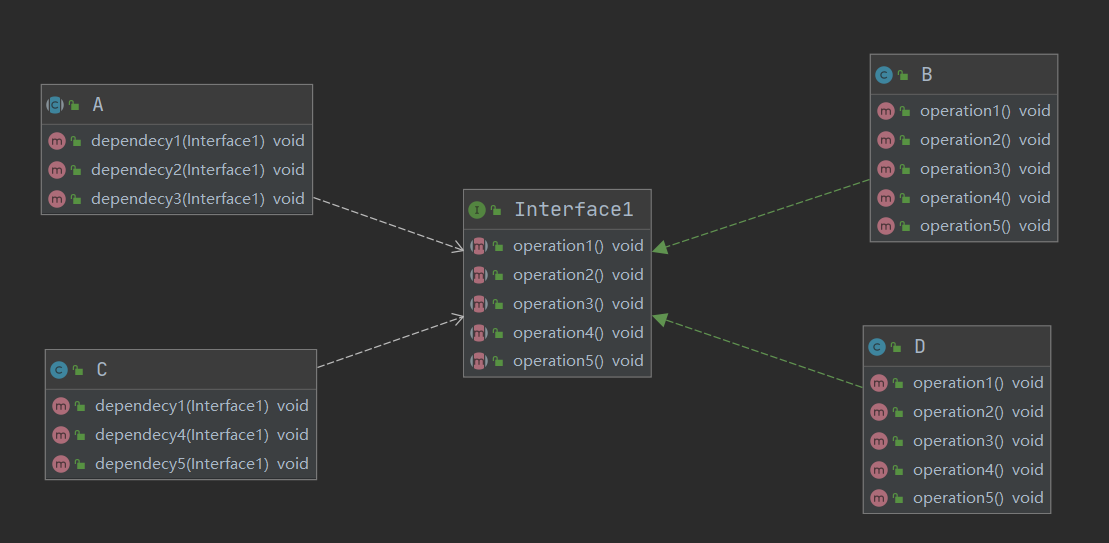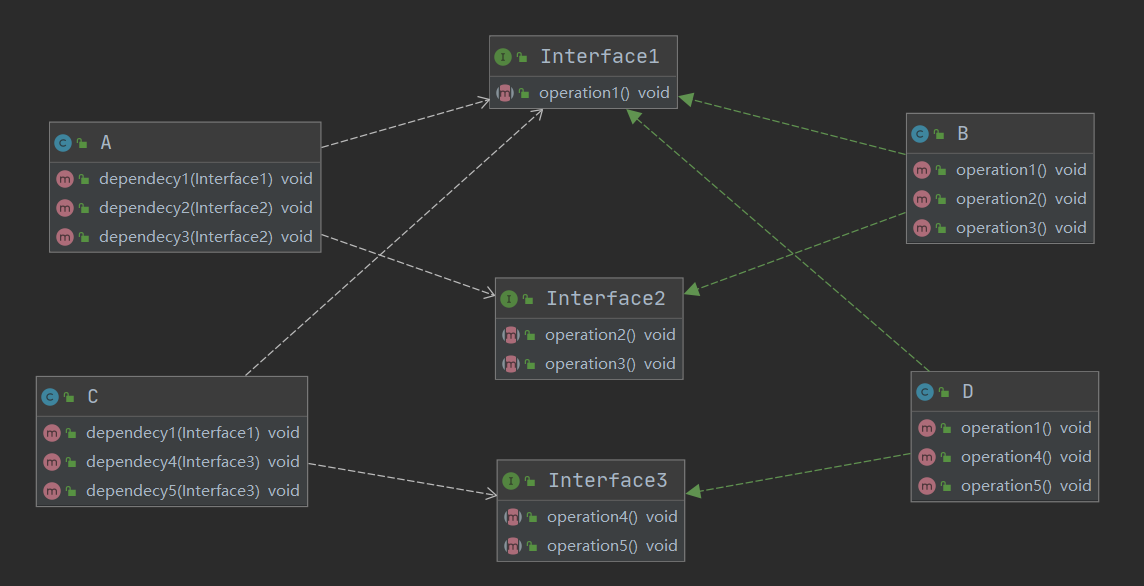设计模式的七大原则
一、设计模式的目的
设计模式主要是为了解决在编写代码过程中,面临的耦合性、内聚性、可维护性、可扩展行、重用性、灵活性等多方面的挑战。
- 代码重用性:相同功能的代码不用多次编写
- 可读性:编程规范,便于他人的阅读和理解
- 可扩展性:当需要添加新功能时,非常的方便
- 可靠性:当增加新的功能后,对原来的功能没有影响
- 最终达到高内聚低耦合的特性
二、设计模式七大原则
设计模式原则,其实就是程序员在编程时,应当遵守的原则,也是各种设计模式的基础。
- 单一职责原则
- 接口隔离原则
- 依赖倒转(倒置)原则
- 里氏替换原则
- 开闭原则
- 迪米特法则
- 合成复用原则
三、单一职责原则
1,基本介绍
对类来说的,即一个类应该只负责一项职责。如类A负责两个不同职责:职责1,职责2。当职责1需求变更而改变A时,可能造成职责2执行错误,所以需要将类A的粒度分解为A1,A2
2,应用实例
a)方案1
/** * 方案1:违反单一职责,所有的交通工具采用同一种方式运行 */ public class SingleResponsibility1 { public static void main(String[] args) { Vehicle vehicle = new Vehicle(); vehicle.run("摩托车"); vehicle.run("汽车"); vehicle.run("飞机"); } } class Vehicle{ public void run(String vehicle) { System.out.println(vehicle + " 在公路上运行...."); } }
b)方案2
/** * 方案2的分析 * 1. 遵守单一职责原则 * 2. 但是这样做的改动很大,即将类分解,同时修改客户端 * 3. 改进:直接修改Vehicle 类,改动的代码会比较少=>方案3 */ public class SingleResponsibility2 { public static void main(String[] args) { RoadVehicle roadVehicle = new RoadVehicle(); roadVehicle.run("摩托车"); roadVehicle.run("汽车"); AirVehicle airVehicle = new AirVehicle(); airVehicle.run("飞机"); } } class RoadVehicle { public void run(String vehicle) { System.out.println(vehicle + " 公路运行"); } } class AirVehicle { public void run(String vehicle) { System.out.println(vehicle + " 天空运行"); } }
c)方案3
/** * 方式3的分析 * 1. 这种修改方法没有对原来的类做大的修改,只是增加方法 * 2. 这里虽然没有在类这个级别上遵守单一职责原则,但是在方法级别上,仍然是遵守单一职责 */ public class SingleResponsibility3 { public static void main(String[] args) { Vehicle2 vehicle2 = new Vehicle2(); vehicle2.run("汽车"); vehicle2.runWater("轮船"); vehicle2.runAir("飞机"); } } class Vehicle2 { public void run(String vehicle) { System.out.println(vehicle + " 在公路上运行...."); } public void runAir(String vehicle) { System.out.println(vehicle + " 在天空上运行...."); } public void runWater(String vehicle) { System.out.println(vehicle + " 在水中行...."); } }
3,注意事项
- 降低类的复杂度,一个类只负责一项职责
- 提交类的可读性,可维护性
- 降低变更引起的风险
- 通常情况下,我们应当遵守单一职责原则。只有逻辑足够简单,才可以在代码级违反单一职责原则;只有类中方法数量足够少,才可以在方法级保持单一职责原则。
四、接口隔离原则
1,基本介绍
客户端不应该依赖它不需要的接口,即一个类对另一个类的依赖应该建立在最小的接口上。
2,应用案例
类A通过接口Interface1依赖类B,类C通过接口Interface1依赖类D。但是类A只需要操作类B中的operation1、operation2和operation3,同时类C也只需要操作类D中的operation1、operation4和operation5,但是由于类B和类D都是接口Interface1的实现类,故而都重写了不需要的方法。

源码:基本案例

public interface Interface1 { void operation1(); void operation2(); void operation3(); void operation4(); void operation5(); } public abstract class A { public void dependecy1(Interface1 interface1) { interface1.operation1(); } public void dependecy2(Interface1 interface1) { interface1.operation2(); } public void dependecy3(Interface1 interface1) { interface1.operation3(); } } public class B implements Interface1{ @Override public void operation1() { System.out.println("B实现了operation1"); } @Override public void operation2() { System.out.println("B实现了operation2"); } @Override public void operation3() { System.out.println("B实现了operation3"); } @Override public void operation4() { System.out.println("B实现了operation4"); } @Override public void operation5() { System.out.println("B实现了operation5"); } } public class C { public void dependecy1(Interface1 interface1) { interface1.operation1(); } public void dependecy4(Interface1 interface1) { interface1.operation4(); } public void dependecy5(Interface1 interface1) { interface1.operation5(); } } public class D implements Interface1{ @Override public void operation1() { System.out.println("D实现了operation1"); } @Override public void operation2() { System.out.println("D实现了operation2"); } @Override public void operation3() { System.out.println("D实现了operation3"); } @Override public void operation4() { System.out.println("D实现了operation4"); } @Override public void operation5() { System.out.println("D实现了operation5"); } }
3,基于接口隔离原则的改进
将接口Interface1拆分为独立的几个接口,类A和类C分别与他们需要的接口建立依赖关系,即采用接口隔离原则。

源码:接口隔离实现

public interface Interface1 { void operation1(); } public interface Interface2 { void operation2(); void operation3(); } public interface Interface3 { void operation4(); void operation5(); } public class A { public void dependecy1(Interface1 interface1) { interface1.operation1(); } public void dependecy2(Interface2 interface2) { interface2.operation2(); } public void dependecy3(Interface2 interface2) { interface2.operation3(); } } public class B implements Interface1, Interface2 { @Override public void operation1() { System.out.println("B实现了operation1"); } @Override public void operation2() { System.out.println("B实现了operation2"); } @Override public void operation3() { System.out.println("B实现了operation3"); } } public class C { public void dependecy1(Interface1 interface1) { interface1.operation1(); } public void dependecy4(Interface3 interface3) { interface3.operation4(); } public void dependecy5(Interface3 interface3) { interface3.operation5(); } } public class D implements Interface1, Interface3 { @Override public void operation1() { System.out.println("D实现了operation1"); } @Override public void operation4() { System.out.println("D实现了operation4"); } @Override public void operation5() { System.out.println("D实现了operation5"); } }
五、依赖倒转原则
1,基本介绍
- 高层模块不应该依赖底层模块,二者都应该依赖其抽象
- 抽象不应该依赖细节,细节应该依赖抽象
- 依赖倒转(倒置)的中心思想是面向接口编程
- 依赖倒转原则是基于这样的设计理念:相对于细节的多变性,抽象的东西要稳定的多。以抽象为基础搭建的架构比以细节为基础的架构要稳定的多。在java中,抽象指的是接口或抽象类,细节就是具体的实现类
- 使用接口或抽象类的目的是制定好规范,而不涉及任何具体的操作,把展示细节的任务交给他们的实现类去完成
2,应用案例
a)方案1
/** * 方案1:完成Person接受消息的功能 * 简单易懂 * 如果我们获取的对象是 微信、短信等,则新增类,同时Person也要增加对应的接收方法 */ public class Person { public void receive(Email email){ System.out.println(email.getInfo()); } } class Email{ public String getInfo() { return "电子邮件信息:hello word"; } }
b)方案2改进
/** * 方案2:依赖倒置原则 * 引入一个抽象的接口IReceiver接口,让不同的接收消息方法都实现这个接口重写getInfo方法 * 由调用方决定传入的具体对象 */ public class Person { public void receive(IReceiver receiver) { System.out.println(receiver.getInfo()); } } interface IReceiver{ public String getInfo(); } class Email implements IReceiver{ @Override public String getInfo() { return "电子邮件信息:hello word"; } } class WeiXin implements IReceiver { @Override public String getInfo() { return "微信信息:hello wechat"; } }
3,依赖关系传递的三种方式(同Spring DI)
a)接口传递

/** * 接口传递的方式,将接口ITV传递open方法 */ class OPenAndClose implements IOPenAndClose { @Override public void open(ITV itv) { itv.play(); } } interface IOPenAndClose { public void open(ITV itv); } interface ITV { public void play(); }
b)构造方法传递

//方式二:构造方法传递 interface IOpenAndClose { public void open();//抽象方法 } interface ITV {//ITV接口 public void play(); } class OpenAndClose implements IOpenAndClose { public ITV tv;//成员 public OpenAndClose(ITV tv) {//构造方法 this.tv = tv; } @Override public void open() { this.tv.play(); } }
c)setter传递

//方式三:setter方法传递 interface IOpenAndClose { public void open();//抽象方法 } interface ITV {//ITV接口 public void play(); } class OpenAndClose implements IOpenAndClose { private ITV tv; public void setTv(ITV tv) { this.tv = tv; } @Override public void open() { this.tv.play(); } }
4,注意事项和细节
- 低层模块尽量都要有抽象类和接口,或者两者都有,提高程序的稳定性
- 变量的声明类型尽量时抽象类或接口,这样我们的变量引用和实际对象间就存在一个缓冲层,利于程序扩展和优化
- 继承时遵循里氏替换原则
六、里氏替换原则
1,OO中继承性的思考和说明
- 继承:父类中凡是已经实现好的方法,实际上是在设定规范和契约,虽然它不强制要求所有的子类必须遵循这些契约,但是如果子类对这些已经实现的方法任意修改,就会对整个继承体系造成破坏。
- 继承在程序设计上带来了便利的同时,也带来了弊端。比如使用继承会给程序带来侵入性,程序的可移植性降低,增加对象间的耦合性。如果一个类被其他的类所继承,则当这个类需要修改时,必须考虑所有的子类,并且父类修改后,所有涉及到子类的功能都有可能产生故障。
2,基本介绍
- 如果对每一个类型为T1的对象o1,都有类型为T2的对象o2,使得以T1定义的所有程序P在所有的对象o1都代换成o2时,程序P的行为没有发生变化,那么类型T2是类型T1的子类型。
- 所有引用基类的地方必须能透明地使用其子类的对象。
- 在使用继承时,遵循里氏替换原则,在子类中尽量不要重写父类的方法
- 继承实际上让两个类的耦合性增强了,在适当的情况下,可以通过聚合、组合、依赖来处理
3,应用案例
a)方案1
public class A { public int fuc1(int a, int b) { return a - b; } } /** * 类B继承A * 由于B无意识重写了A的fuc1方法,导致最终调用时发现预期类A的fuc1不生效 */ class B extends A { public int fuc1(int a, int b) { return a + b; } public int fuc2(int a, int b) { return a * b; } }
b)方案2改进
//定义基类 public class Base { } class A extends Base { public int fuc1(int a, int b) { return a - b; } } /** * 类A和类B继承Base类 * B使用组合的方式使用A,这样fuc3仍然是类A的方法 */ class B extends Base { A a = new A(); //这里,重写了 A 类的方法, 可能是无意识 public int fuc1(int a, int b) { return a + b; } public int fuc2(int a, int b) { return fuc1(a, b) + 9; } //我们仍然想使用 A 的方法 public int fuc3(int a, int b) { return this.a.fuc1(a, b); } }
七、开闭原则
1,基本介绍
- 开闭原则是编程中最基础、最重要的设计原则
- 一个软件实体如类、模块和函数应该对扩展开发(指对提供方开放),对修改关闭(指对使用方关闭)。用抽象构建框架,用实现扩展细节
- 当软件需要变化时,尽量通过扩展软件实体的行为来实现变化,而不是通过修改已有的代码来实现变化。(尽量增加一种功能/扩展,而不是修改这部分可能正在使用的功能)
- 编程中遵循其他原则,以及使用设计模式的目的就是遵循开闭原则
2,应用案例
a)方案1
public class OCP { public static void main(String[] args) { GraphicEditor graphicEditor = new GraphicEditor(); graphicEditor.drawShape(new Rectangle()); graphicEditor.drawShape(new Circle()); } } //绘图的类,使用方 class GraphicEditor{ //根据不同的type绘制不同的图 public void drawShape(Shape s) { if (s.type == 1) { drawRectangle(s); } else if (s.type == 2) { drawRectangle(s); } } public void drawRectangle(Shape r) { System.out.println("绘制矩形"); } public void drawCircle(Shape r) { System.out.println("绘制圆形"); } } //基类 abstract class Shape{ int type; } class Rectangle extends Shape { public Rectangle() { super.type = 1; } } class Circle extends Shape { public Circle() { super.type = 2; } }
问题:该方案违反了设计模式的开闭原则,当需要增加一个图形种类(例:三角形),不仅需要新建类,而且使用方代码也需要添加适配
b)方案2改进
public class OCP { public static void main(String[] args) { GraphicEditor graphicEditor = new GraphicEditor(); graphicEditor.draw(new Rectangle()); graphicEditor.draw(new Circle()); } } class GraphicEditor{ public void draw(Shape s) { s.draw(); } } abstract class Shape{ public abstract void draw(); } class Rectangle extends Shape { @Override public void draw() { System.out.println("绘制矩形"); } } class Circle extends Shape { @Override public void draw() { System.out.println("绘制圆形"); } }
八、迪米特法则
1,基本介绍
- 一个对象应该对其他对象保持最少的了解
- 类与类关系越密切,耦合度越大
- 迪米特法则又叫最少知道原则,即一个类对自己依赖的类知道的越少越好。也就是说,对于被依赖的类不管多么复杂,都尽量将逻辑封装在类的内部。对外除了提供public方法,不对外泄露任何信息
- 迪米特法则还有个更简单的定义:只与直接的朋友通信
- 直接的朋友:每个对象都会与其他对象有耦合关系,只要两个对象之间有耦合关系,我们就说这两个对象之间是朋友关系。耦合的方式很多,依赖、关联、组合、聚合等。其中,我们成出现成员变量、方法参数、方法返回值中的类为直接朋友,而出现在局部变量中的类不是直接的朋友。也就是说,陌生的类最好不要以局部变量的形式出现在类的内部。
2,应用实例
有一个学校,下属有各个学院和总部,现要求打印出学校总部员工 ID 和学院员工的 id
a)方案1
public class Demeter { public static void main(String[] args) { SchoolManage manage = new SchoolManage(); manage.printAllEmp(new CollegeManage()); } } //学校总部员工 class Employee { private String id; public String getId() { return id; } public void setId(String id) { this.id = id; } } //学院员工 class CollegeEmployee { private String id; public String getId() { return id; } public void setId(String id) { this.id = id; } } //学院管理 class CollegeManage { public List<CollegeEmployee> getAllEmployee() { List<CollegeEmployee> list = new ArrayList<CollegeEmployee>(); for (int i = 0; i < 10; i++) { CollegeEmployee emp = new CollegeEmployee(); emp.setId("学院员工 id= " + i); list.add(emp); } return list; } } //学校总部管理 class SchoolManage { public List<Employee> getAllEmployee() { List<Employee> list = new ArrayList<Employee>(); for (int i = 0; i < 10; i++) { Employee emp = new Employee(); emp.setId("学校总部员工 id= " + i); list.add(emp); } return list; } //这里的 CollegeEmployee 不是 SchoolManager 的直接朋友 //违反了迪米特法则 public void printAllEmp(CollegeManage collegeManage) { List<CollegeEmployee> allEmployee = collegeManage.getAllEmployee(); System.out.println("------------学院员工------------"); for (CollegeEmployee e : allEmployee) { System.out.println(e.getId()); } //获取到学校总部员工 List<Employee> list2 = this.getAllEmployee(); System.out.println("------------学校总部员工------------"); for (Employee e : list2) { System.out.println(e.getId()); } } }
问题:由于在SchoolManage中,CollegeEmployee类并不是SchoolManage类的直接朋友。按照迪米特法则,应该避免类中出现这样非直接朋友关系的耦合
b)方案2
优化:完整代码
//学院管理 class CollegeManage { public List<CollegeEmployee> getAllEmployee() { List<CollegeEmployee> list = new ArrayList<CollegeEmployee>(); for (int i = 0; i < 10; i++) { CollegeEmployee emp = new CollegeEmployee(); emp.setId("学院员工 id= " + i); list.add(emp); } return list; } //在学院管理中增加遍历类,方便直接被调用 public void printCollegeEmp() { List<CollegeEmployee> allEmployee = this.getAllEmployee(); System.out.println("------------学院员工------------"); for (CollegeEmployee e : allEmployee) { System.out.println(e.getId()); } } } //学校总部管理 class SchoolManage { public List<Employee> getAllEmployee() { List<Employee> list = new ArrayList<Employee>(); for (int i = 0; i < 10; i++) { Employee emp = new Employee(); emp.setId("学校总部员工 id= " + i); list.add(emp); } return list; } public void printAllEmp(CollegeManage collegeManage) { collegeManage.printCollegeEmp(); //获取到学校总部员工 List<Employee> list2 = this.getAllEmployee(); System.out.println("------------学校总部员工------------"); for (Employee e : list2) { System.out.println(e.getId()); } } }
3,注意事项
- 迪米特法则的核心是降低类之间的耦合
- 由于每个类都减少了不必要的依赖,因此迪米特法则只是要求降低类间(对象间)耦合关系,并不是要求完全没有依赖关系
九、合成复用原则
1,定义
- 合成复用原则是指尽量使用对象组合/聚合,而不是继承关系达到软件复用的目的。可以说使系统更加灵活,降低类与类之间的耦合度,一个类的变化对其他类造成的影响相对较少。
- 继承我们叫做白箱复用,相当于把所有的实现细节暴露给子类。组合/聚合也称之为黑箱复用,对类以外的对象是无法获取到实现细节的。要根据具体的业务场景来做代码设计,其实也都要遵循OOP模型。
十、 设计原则核心思想
- 1)找出应用中可能需要变化之处,把它们独立出来,不要和那些不需要变化的代码混在一起。
- 2)针对接口编程,而不是针对实现编程。
- 3)为了交互对象之间的松耦合设计而努力




 浙公网安备 33010602011771号
浙公网安备 33010602011771号